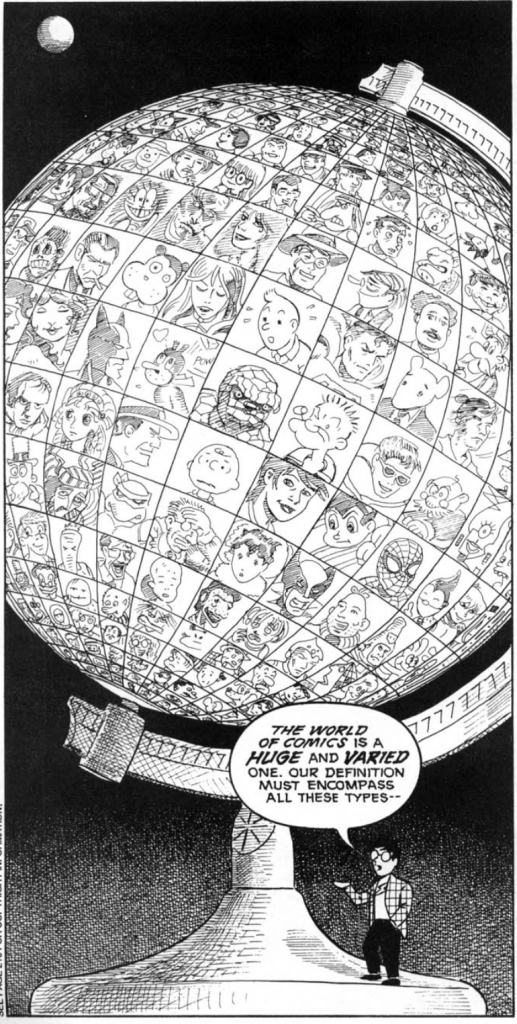Sequential Art:
A sequence of still pictures that create a story, these pictures usually hint at a form of motion or progression of the story. This term can be applied to Graphic Novels, Film, and Comics.

Visual Vocabulary:
In the context of Scott McCloud, Scott uses this term to comment on single-panel comics. Visual Vocabulary in here refers to the defining features and aesthetics of visual images, ie the Visual Vocabulary of cartoons and their distinct characteristics that classify them as cartoons.

Representational Art:
Artwork that represents certain things, say for example political art having an implied metaphor on something, or editorial illustration eluding to certain things. Drawings in of itself are representational art, a famous example being Magritte’s, This is not a Pipe painting.

Icon: An image used to represent a person, place, thing, or Idea. Just like representational art, Icons are made so humans can easily identify things and associate an image with their real-life counterpart. Scott McCloud makes a great point about comic art being icons themselves, as the more realistic things get, the less we can empathize and associate ourselves with the icon.

Amplification through Simplification: The idea of creating visual juxtaposition by hyper focusing on specific details and exaggerating certain actions. Doing so amplifies an action or idea.

Closure: The idea of observing certain key elements in a drawing/painting and letting the viewer essentially “Fill in the Blank”, creating a whole picture/movement inside the viewer’s head.

Gutter: Space between comics and panels. They can vary in size and spacing to show time moving forward or backwards.
–
The spacing between these blocks is an example of a gutter
–
Visual Iconography: The language of pictures, how they are formed and how they are represented are all parts of Visual Iconography. Closure works in tandem with Visual Iconography, linking time and motion to the icons.

Moment to Moment: Jumps in time between panels to represent a slow pacing, This type of closure is used to emphasize important events or gestures in the story.

Action to Action: Jumps in time between panels to represent movement through actions. This type of closure is used to display any type of action that can move the story forward with a faster pace compared to Moment to Moment.

Subject to Subject: Jumps in time between panels to represent time moving from one subject to another. This type of closure is used to link panels together and create movement in time and space.

Scene to Scene: Jumps in time between panels to represent time moving from one place to another. This type of closure is used to link panels together and create significant movement in time and space.

Aspect to Aspect: Movement from panel to panel that relates to certain places, ideas, or moods. Time and Space is not very apparent here, however the ideas and moods are often linked together here.

Non-Sequitor: Mostly a jumble of random things put together with no logical relation whatsoever.

Intervening Moments: Moments not shown in panels; the time and actions that progress between panels.

Motion Line: Lines that depict motion, usually used to show that objects are travelling from one space to another. These motion lines usually involve streaking, the visual representation of objects in movement leaving trails to show how movement was made.

Word Balloons: Balloons that contain words or information prevalent to the story. Word balloons are usually used by characters to illustrate dialogue.

Expressive Potential: In the context of Scott McCloud, Expressive potential refers to how the quality of lines and drawn artwork impact the impression of drawings and their characteristics.

Symbols: Things that are used in drawings or icons to give more meaning towards an object. Symbols usually relate to how people perceive things, and can show visible and invisible representations of things.

Synaesthetics: When senses are connected together through one medium. Some things that relate to this idea are the idea of meanings behind colours and how certain sounds can link taste/touch etc.

Word Specific Combination: When images are separated from words and the images illustrated don’t largely contribute to the understanding of the text.

Picture Specific Combination: When Words are separated from Images, and the images do most of the brunt work in telling the story. Words in this scenario do little to aid the images.

Duo Specific Combination: If you want to really say something. The idea that the images and text essentially say the same thing.

Additive Combination: When words or images amplify each other to create a stronger expression.

Parellel Combinations: When words and pictures follow different courses without interacting.

Montage Combination: When images and words are intertwined into each other to create a whole image.

Interdependent Combination: When words and pictures go hand in hand to create a cohesive idea; in this case the words or images cannot be replaced with a better alternative.

Leave a Reply